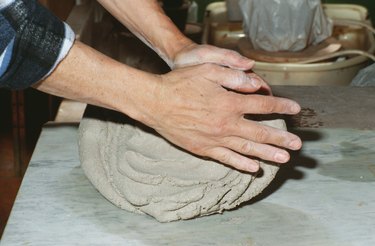
Whether you are using natural or polymer clay for fired pottery, you may pick up your block one day to find it has hardened to a point where you can no longer work with it. Sometimes shipped clay will have a torn plastic wrapper that has allowed air in, and your clay will be almost a brick. Fortunately, there are a few sound techniques for re-softening that clay.
Natural Clay – Soaking
Video of the Day
Natural clay that has barely any give left still contains moisture, so it hasn't yet turned to rock. With this kind of clay, you can forcefully spread it into a large, flat loaf with slightly raised edges. Take a chopstick or a dowel and a mallet, and punch a lot of holes, very close to one another, into the top surface of the clay loaf. Punch only about three-quarters of the way through; the bottom should remain watertight. Fill the loaf with water, which will be contained within the raised edges, filling the holes as well. Place the loaf in a plastic bag, and seal the bag. Wait two days, and you should find the clay malleable again.
Video of the Day
Natural Clay – Grinding and Re-Wetting
If your natural clay has gone stony, break out the mortar and pestle. With a hammer, chip off pieces of the hardened clay, and grind the pieces to dust with the mortar and pestle. Clay dust is not particularly healthy, so wear a dust mask while you do this, and sweep up well afterwards. Mix the re-ground dust with water until it is a slurry – that is, slightly thicker than a biscuit gravy. Leave the slurry uncovered to soak, kneading occasionally, until it dries into a doughy consistency, whereupon you can work with it again.
Polymer Clay – Kneading
Polymer clays are made with particle of polyvinyl chloride — that's right, PVC, like the stuff in many plumbing pipes. The PVC is suspended in a compound made of petroleum distillates. Polymer clays will soften with handling. They respond to pressure and warmth, so simply mashing and kneading them will soften them enough to sculpt or make pottery. This "conditioning" is actually standard operating procedure for anyone about to work with polymer clay, which ought to be stored in airtight containers.
Polymer Clay – Recuperating
Once polymer clay is fired, the molecular structure changes; so the clay can never be re-pulverized and used again. Sometimes, however, the unfired clay can get too hard to work with and resistant to regular kneading. Some people will run the polymer clay through a pasta machine to break it up, adding a special dilutant for polymer clay. If you don't have a pasta machine, just cut it into malleable strips withe a knife. Never use a pasta machine to make pasta once you have used it to manipulate polymer clay; and never use polymer clay pots for food in any way. Some of the compounds in the clay and the dilutant are toxic.